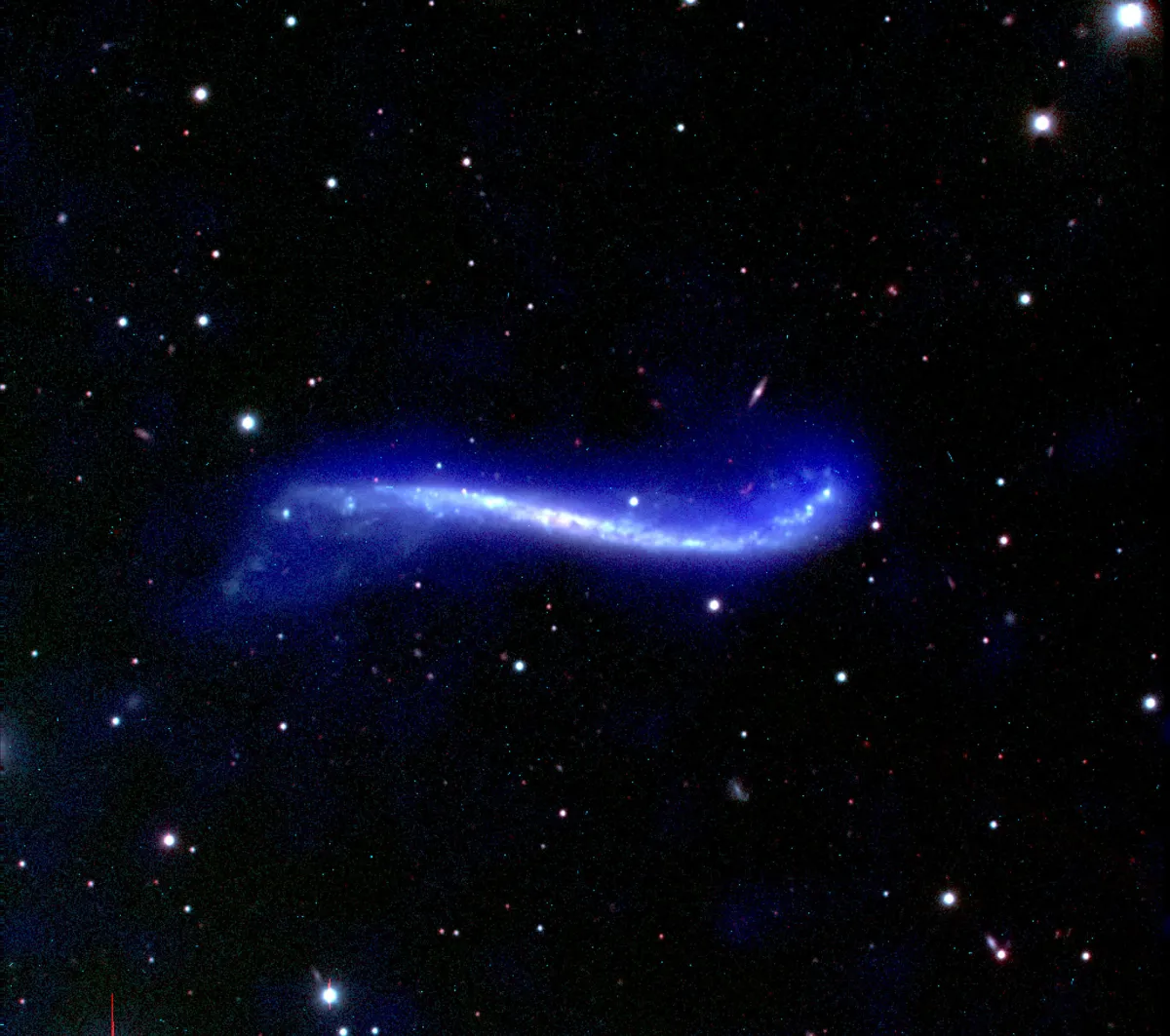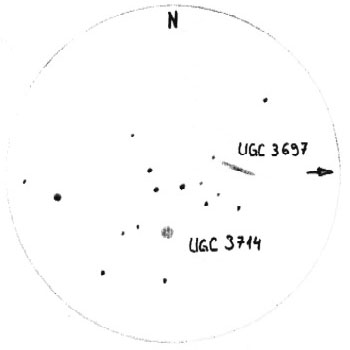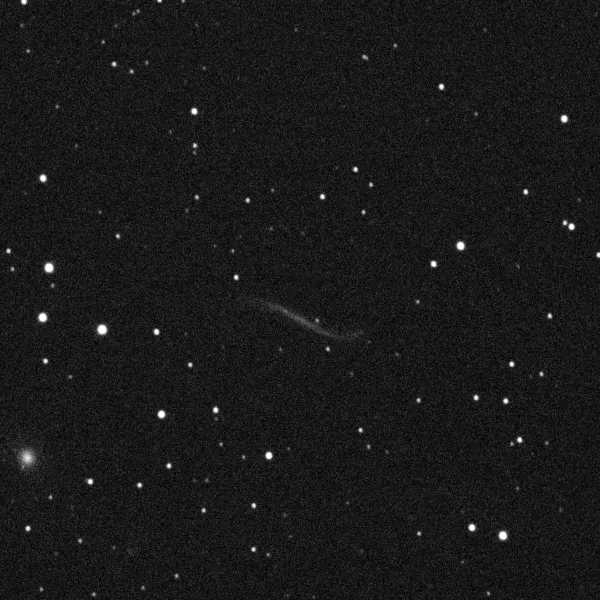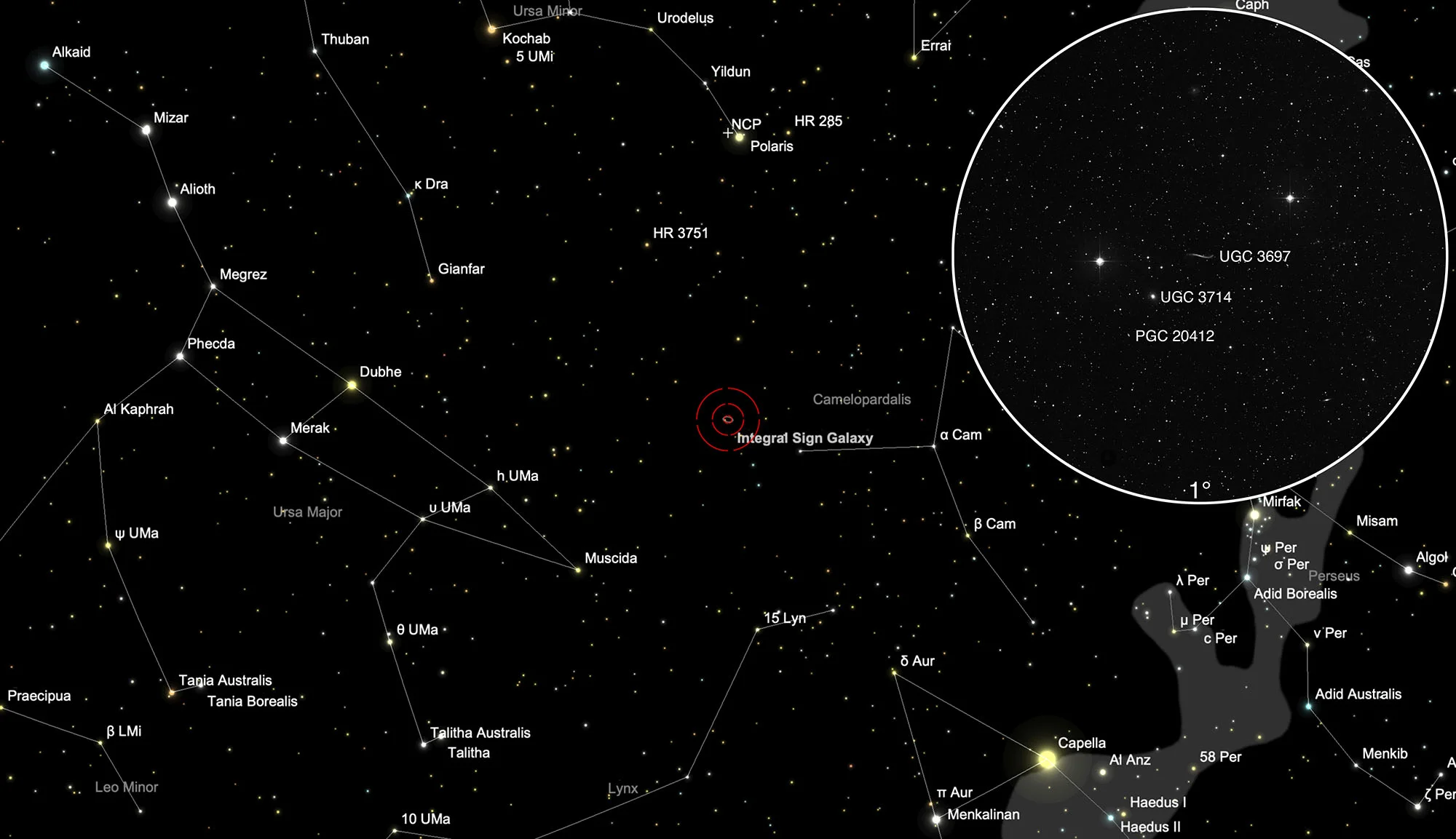Integral Sign Galaxy (UGC 3697)

History
The «Integral Sign Galaxy» (GB 1) was found in 1967 by Geoffrey Burbidge in an idle perusal of the photo plates of the «Palomar Observatory Sky Survey». No other galaxies with that unusual form of an integral sign were known at that time. [490]
Physical Properties
UGC 3697 is a low-mass, Sd spiral galaxy. It shows a super thin disk morphology, that we see edge-on. It is warped like a potato chip or a music record that was too long in the sun. Some degree of warping is observed in a large fraction of galaxies, but only few are warped as much as UGC 3697. In contrast to normal edge-on spirals, where the brightest concentration of H-I is typically found near the central regions of the galaxy, UGC 3697 shows a bright blob of emission near its western edge. Gas filaments also extend from this location, reaching up to ∼7 kpc from the plane. Neither the filaments nor the bright midplane clump have any obvious optical counterparts.
UGC 3697 is part of a small galaxy group that includes the peculiar elliptical galaxy UGC 3714 and several dwarf galaxies. UGC 3714, at a projected distance of 39 kpc from UGC 3697, is the optically brightest group member, and has long been presumed to be responsible for exciting the warp of UGC 3697 via tidal effects. However, tides are rather inefficient warp drivers. New observations have revealed strong evidence that the galaxy recently had merged with a satellite dwarf galaxy. [491]
Apparent magnitudes in different filters are: B 13.1 mag, J 11.508 mag, H 10.822 mag, K 10.528 mag. The distance is given with 46.27 Mpc. [145]
| PGC | RA | Dec | Type | Dim | Btot | HRV | PA | Names |
|---|---|---|---|---|---|---|---|---|
| PGC 20348 | 07 11 21.3 | +71 50 06 | S | 3.3 x .2 | 13.3 | 3137 | 76 | UGC 3697, MCG 12-7-28, CGCG 330-26, IRAS 7055+7155, ANON 705+71 |
| PGC 20398 | 07 12 33.8 | +71 44 56 | S | 1.8 x 1.6 | 12.7 | 3051 | 35 | UGC 3714, MCG 12-7-32, CGCG 330-30, ANON 706+71 |
| PGC 20412 | 07 13 04.5 | +71 39 58 | .4 x .2 | 15.9 | CGCG 330-32 |
Finder Chart
The galaxy UGC 3697 is located in the constellation Camelopardalis. In that area of the sky there are only dim stars, so aligning the Telrad circles is a bit challenging. But the two bright stars within 1° field of view guide you to the galaxy, which lies in the middle. On 7 January it is in opposition to the Sun and culminates at local midnight. The best viewing time is September to June when it is highest at night.
Visual Observation

320 mm Aperture: Visually, no integral sign can be seen, but a narrow, elongated line. With a brightness of 14.5 mag, the galaxy is easily recognizable under dark, alpine skies. The two 6.4 mag and 7.0 mag bright stars and the prominent triangle with 11m stars are helpful for the search. The UGC 3714 with 12.7 mag indicates that you are in the right star field. A mag 14.7 star is right next to the integral sign galaxy we are looking for. The faint galaxy PGC 20412 with 16.0 mag can be tried as an encore. Provided you have the best viewing conditions and a lens opening of more than 320 mm. — 12.5" Ninja-Dobson, F:4.5, TV-Radian 8 mm 181x, 0.33°, Eduard von Bergen [192]

400 mm Aperture: In the 21mm Ethos eyepiece, the first thing pops out are the two bright stars and the brighter, round galaxy UGC 3714. With averted vision, UGC 3697 can be seen as a pale line. In the 9 mm Nagler (200x), UGC 3697 remains a pale line that can only be seen indirectly. Nothing is visible of the curved ends. — 400 mm f/4.5 Taurus Dobsonian, Hasliberg, SQM 21.0, 3. 2. 2024, Bernd Nies
762 mm Aperture: The integral sign galaxy UGC 3697 lived up to its name and could be seen visually as a curved line in the 30" Dobsonian. The slightly puffy and spherical galaxy UGC 3714 could also be found nearby. The EAA photo with only 8 seconds exposure time at ISO 40'000 in black and white reflects the visual impression almost well. — 30" SlipStream-Dobson f/3.3, EAA-Photo, Canon EOS R, 8s at ISO 40'000, Hasliberg, 04. 02. 2024, Eduard von Bergen
